Software Spotlight: Lotus Jazz
Lotus Jazz was a heavily marketed all-in-one integrated office suite that included a word processor, spreadsheet, graphing, database, and communications program. Jazz was targeted as a universal solution for all office workers. Although at release, the program was exclusively for the Apple Macintosh 512k. Despite the marketing effort, it flopped miserably. Even though it was from Lotus, the spreadsheet was not related to Lotus 1-2-3.
Lotus Jazz motivated Microsoft to purchase Mouseworks that became Microsoft Works.
https://winworldpc.com/product/lotus-jazz/
I remember hearing a lot about Lotus Jazz back in the day. I never understood what it was supposed to be, what the point of it was, or why anyone would want it. Like most people, what I understood was that it WAS NOT Lotus 1-2-3, and what everyone wanted was: Lotus 1-2-3.
Why didn't Lotus just port 1-2-3 to the Macintosh like everyone wanted? My best guess is that with the differences and limitations of the 1985 Macs, anything they ported would not live up to the name.

Jazz came across as something vastly different and foreign. It doesn't even appear compatible with Lotus 1-2-3 or Symphony at all. The Apple Macintosh was already vastly incompatible with IBM PCs, as they were completely unable to exchange floppy disks or file formats. I think Lotus 1-2-3 users considering switching from PC to Mac would have preferred something that at least claimed to be familiar to welcome them on the strange new Mac.
It sounds like Lotus was trying to "reinvent" spreadsheets, and getting caught up in the integrated office suite hype.
Why go to all the trouble instead of porting or creating just a new spreadsheet program?

I finally obtained an original copy of Lotus Jazz, but it has the same problem I had with Excel: https://forum.winworldpc.com/discussion/11589/copy-protected-excel-1-00-now-what I have no way to run it, as existing emulators don't like the copy protection. Writing it back as-is to a floppy may or may not work due to signal degradation and incompatibilities with Apple's VBR GCR.
The protection SEEMS to be an intentionally bad sector, but the disk was in such bad condition it is hard to tell for sure.
Fortunately, I did stumble across what appears to be an unprotected copy, so we can try it out.

So why did Jazz flop so hard? There were a number of reasons.
First, as I mentioned it was copy protected. Having the master disk fail was a significant risk. When it was released, the only Macintosh supported was the Mac 512k. It sounds like it may have run on the Mac Plus, but it was reported that the copy protection made it incompatible with the Macintosh II.
The Apple Macintosh 512k was woefully underpowered for this kind of application. A single drive system required lots of disk swapping just to run the program. The Macintosh users with hard drives still had to constantly feed it the master disk due to the copy protection.
The Apple Macintosh computers could not easily interchange data with IBM PCs due to completely different floppy disk formats. Also factor in that at the time Macintosh computers were not widely used in businesses, where one would commonly use spreadsheets.
Jazz was considered overpriced. Home users were not going to pay the same exorbitant amounts that corporate users would, especially with all the drawbacks.
The software was rather buggy. Not sure how buggy, but this seemed to be a common complaint.
Reportedly, Microsoft had an underhanded exclusive deal with Apple to provide them with their Multiplan spreadsheet. It is not clear how much of a hindrance this was, but it would have prevented Apple from providing assistance or support.
Finally, it just WASN'T Lotus 1-2-3. I'm still not sure how compatible it is, if at all, but most 1-2-3 users with complex spreadsheets needed the assurance that any different software was fully compatible. The Macintosh's own incompatibilities certainly did not help.

There was one update to Lotus Jazz (version "1A"). It fixed some bugs, but was still copy protected. It did change the protection so hard drive users did not constantly need to insert the master disk.
An update to Jazz code named "Modern Jazz" was canceled, and a piss-poor adaptation of Lotus 1-2-3 was released instead.
One very significant thing that came from all of this - the Jazz product motivated Microsoft to purchase Mouseworks, a similar all-in-one integrated office suite, that became Microsoft Works.
Wanted: Jazz "1A" update.
Wanted: Jazz Manual scans
Wanted: Lotus 1-2-3 1.0 for Mac and manuals (we have 1.1 for Mac)

Comments
The other side effect of the announcement of Jazz was Microsoft's encouragement of Andy Herzfeld to write what became Switcher so MS could have Excel and Word running on the same Mac at the same time. Once that happened, high priced integrated packages were doomed. It does show how inefficiently Jazz was programmed. Under Switcher on a Mac 512, there was room for Excel, Word, and a communications program each stronger than the modules bundled in Jazz. Jazz shared code and was simpler; Jazz should have used less memory. Modern Jazz supposedly added the needed features while cutting memory requirements which shows that it takes time to learn to program an environment.
Lotus seemed to be expecting a transition to office suites. They had the first iteration of Symphony and there were third party word processor add-ons to 1-2-3 like 4Word and InWord. The Mac couldn't task switch so building a complete suite that could switch internally seemed a good idea. Jazz flopped but the more traditional spreadsheet of Multiplan for Mac wasn't all that successful either. Nor was MacCalc. It took the development of Excel with the higher end graphics to give the Mac user base what they wanted.
One item that can only be seen through actual use is how Jazz implemented updating between the various modules. Insert a chart in a word processing document and then change the numbers in the spreadsheet and the chart in the word processor would automatically update to reflect that. Even better, there was an option to sometimes turn that off so annual reports could retain information as of the time of writing. Much easier than the DDE links MS tried in Windows and a better conceptual design than either OLE or CORBA from the mid-90s.
One clear thing I recall was that 1-2-3 for the PC could support a much bigger spreadsheet in RAM than the early Mac programs. 512k was pretty small next to 2,048k+ that a good PC could support. I also recall a number of developers complaining that the 128k limit on the original Mac was not nearly enough. I think the prior comment about how "it takes time to learn to program an environment" adds to the equation as well.
Managed to get it running in PCE-Mac. Had to update to the latest version and then just do a direct conversion to PRI format with the commands:
pfi "track00.0.raw" disk1.pfi
pfi disk1.pfi -c 00-15 -R 2 -r 381310 -p decode pri diska.pri
pfi disk1.pfi -c 16-31 -R 2 -r 349510 -p decode pri diskb.pri
pfi disk1.pfi -c 32-47 -R 2 -r 317700 -p decode pri diskc.pri
pfi disk1.pfi -c 48-63 -R 2 -r 285950 -p decode pri diskd.pri
pfi disk1.pfi -c 64-79 -R 2 -r 254190 -p decode pri diske.pri
pri diska.pri -m diskb.pri -m diskc.pri -m diskd.pri -m diske.pri program.pri
Then mount the PRI image in to a drive in the emulator.
The conversion can be simplified. There are two ways to convert a variable bit rate Macintosh floppy disk image that has been captured by a fixed RPM drive. One is to adjust the RPM value in the source image and decode with a constant bit rate:
The other is to decode with a variable bit rate. The pri utility knows about Mac disks, so this can be simplified:
Thanks for pointing that out. Of course, I did it the hard way
That pri-mac decoding option is fairly new, I think, so had not tried it yet.
https://winworldpc.com/product/lotus-jazz/1x
It appears the 1.0A package came with the same three single sided 1.0 disks specifically for the Mac 512K, and one additional double sided disk containing 1.0A specifically for the Mac Plus. The two program disks would share the same startup and primer disk.
Oddly, the 1.0A disk looks like it is not copy protected, while the 1.0 disk still is. These disks are used, so I don't really know if the original user changed anything.